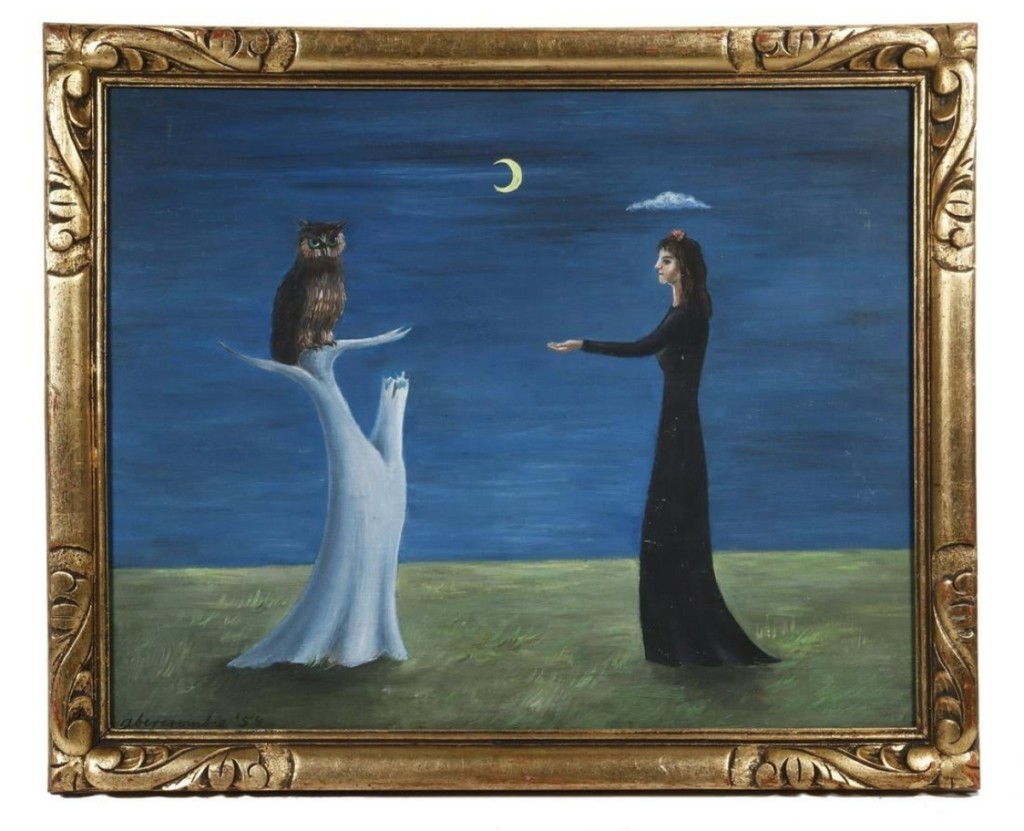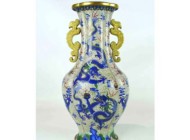
“Cook House, Home Hills,” an oil on linen dated 2000 by New Zealand artist Grahame Sydney, earned the top price of the sale, $64,350.
Review and Onsite Photos by Rick Russack, Additional Photos Courtesy Thomaston Place Auctions Galleries
THOMASTON, MAINE – Between February 28 and March 1, Kaja Veilleux’s Thomaston Place Auction Galleries offered more than 1,350 lots. Day one presented Civil War material, photographs and ephemera, topped by a rare Lincoln-Johnson campaign flag, which brought more than $38,000, leading the day. Day one also included Asian material and firearms.
Day two offered a wide selection of American and European paintings, including dozens of marine paintings, ship models, American furniture, folk art, additional fine art and early ceramics. A painting of a young woman holding a rose by French artist Charles Amable Lenoir, finishing at nearly $41,000, topped the day.
Day three offered still more paintings, toys, advertising, Twentieth Century decorative arts, porcelain and art glass. A painting done in 2000 by a New Zealand artist, bringing $64,350, led the day and topped the three-day sale. There was a good crowd in the salesroom, and there were several absentee bids. Phone lines were busy, as were the internet bidding platforms.
To a history buff, the most interesting item in the sale was the Lincoln-Johnson campaign flag with the word “Free” spelled out by the 35 stars. The flag, which realized $38,025, was bought by Jeff Bridgman, longtime dealer in flags and well-respected expert in the field. When later asked what made this flag so special, he said, “There are lots of things that contribute to this flag’s interest. First of all, there’s only one other example known and it’s in a private collection. It’s average size for over-printed campaign flags, but the fact that the stars spell out the word ‘Free’ is special. I don’t think there are more than ten such examples in existence – for any campaign. Then there’s the fact that it’s from the Lincoln-Johnson campaign. Lincoln-Hamlin flags are seen much more often. Only about 20 percent are for this campaign. Add to all this the fact that the existence of this flag was unknown, and you have a really special piece. I’m delighted to be able to own it.”

Creating a lot of presale interest and achieving the second highest price of the sale was a painting by Gertrude Abercrombie. It was probably a self-portrait, titled “Woman Supplicates Owl in Shattered Tree,” and it attained $58,500.
Other ephemera sold the first day included a Civil War silk guidon with regional interest. It was carried by Company A of the 9th Maine Volunteer Infantry. The unit, mustered in 1861, saw service at several key battles, including Cold Harbor. It sold for $1,872. There were several batches of Civil War period letters, including a lot with more than 100 from abolitionist Congressman William Morris Davis, who served 1861-1863. With several other pieces of ephemera, it sold for $7,605. Bringing the same price was an autograph album assembled by Davis with ten autographs of Lincoln and his cabinet, plus more than 200 autographs of war-time congressmen and senators.
There were several lots of important material, including photographs and correspondence, relating to spiritualist James Valentine Mansfield, one of the foremost spiritualists during the first period of interest in that field. He was “consulted” by numerous well-known personalities, including Mary Todd Lincoln, who asked him to help communicate with her deceased son Willie, and later with Abraham Lincoln. Mansfield was also asked by Edwin Booth to help communicate with his brother, Lincoln’s assassin, John Wilkes Booth. A lot with more than 1,700 pages of Mansfield’s transcribed correspondence during time he spent in San Francisco from 1862 to 1864 sold for $7,605. In 1879, Mansfield was charged for practicing medicine without a license for his work with Commodore William Vanderbilt, and Mansfield’s testimony in that trial, about 60 handwritten pages, sold for $878. A daguerreotype of Mansfield and his family brought $819. Mansfield’s relationship to the Shakers was documented through several lots of photographs and memorabilia pertaining to prominent Shakers, such as Joseph Meacham, Frederick Evans and others. There were several other lots of Mansfield letters, which also did well. However, not all were believers; Mark Twain considered him a fraud.
The first day included several of the 150 lots of Asian material, most notably a carved celadon jade bowl depicting trees, squirrels, bats and cranes that brought $6,435 and an ornately carved Nineteenth Century Chinese display cabinet displaying dragons and other figures, which earned $2,925.
The three-day sale included more than 200 paintings, many of which were marine scenes, and it was the paintings that brought the highest prices of the sale. On the third day, “Cook House, Home Hills,” an oil on linen dated 2000, by New Zealand artist Grahame Sydney (b 1948) earned the top price of the sale. It was a peaceful scene, with one small house, set in a browning field against blue sky. Several books have been written about the artist, and his works are in several museum collections. He is also a prolific printmaker, and his prints are available on his website. Finishing at $40,950, leading day two of the sale was a life-sized romantic portrait by French artist Charles Amable Lenoir (1860-1926). “The Wild Rose” depicted a young woman seated in the woods, holding a flower. Lenoir won awards all over Europe, including, in 1903, the French Legion of Honor.
Numerous marine paintings sold on the second day included works by Jacobsen, Blake, Badger, Richards, Stubbs and others. Most of the marine paintings had come from Maine estates, one of which was on Southport Island. “Bringing Her Into New York Harbor,” showing an American bark under full sail with a tug nearby by Antonio N.G. Jacobsen (1850-1921) earned $16,380, the most successful of the marine paintings. A portrait of the four-mast schooner Addison E. Bullard painted by Solon F.M. Badger (1873-1919) sold for $10,530. The ship had been built in Rockport, Maine, in 1914 and was destroyed by fire in 1919. There were marine paintings in all price ranges.

The highest price of the second day of the sale, $40,950, was earned by this life-sized portrait by French artist Charles Amable Lenoir. “The Wild Rose” depicted a young woman sitting in the woods, holding a flower.
The second highest price of the sale was achieved by a painting by Gertrude Abercrombie (1909-1977). It was probably a self-portrait, titled “Woman Supplicates Owl in Shattered Tree,” and it attained $58,500. Abercrombie was active in Chicago in the 1930s-40s and associated with jazz greats Dizzy Gillespie, Charlie Parker and Sarah Vaughn.
Furniture and folk art sold on the second day, again with the reminder that sometimes great things don’t sell. A huge Nineteenth Century carved eagle with excellent detail and a wingspread of 77 inches did not find a new home. In better times it had adorned New York’s Tavern on the Green. But other carved eagles and Bellamy-style wall plaques did sell, as did numerous half-hull models and folk-art ship dioramas, the nicest of which was bought by antiques dealer Butch Berdan. He commented, “They’re not always easy to sell, but this one is really about as good as they get.” A large carved wood figure of a ship’s captain dressed in a blue uniform and holding a sextant went out for $5,850. A well-weathered double-sided trade sign in the form of a crab from Baker’s Lobster Shack, Point Pleasant, N.J., sold for $6,435. It had hand-forged iron hangers, a red surface and was 59 inches wide.
In total, there were more than 200 lots of furniture, most of it American. The most expensive piece, however, at $10,500, was English. It was a Georgian mahogany mechanical drawing desk with a ratcheted easel top and swing-out candleholders. Also English was an oak Seventeenth Century tavern table with turned legs and stretchers, which brought $4,388. The most sought-after early American lot was a pair of Federal period wing chairs with turned and tapered front legs. Nicely upholstered, the pair realized $4,973. Attributed to Newtown, Conn., cabinet maker Joel Booth, a fan-carved Chippendale lowboy with carved knees and ball and claw feet achieved $4,095. But as often happens, an Eldred Wheeler reproduction Dunlap-style tiger maple highboy brought more than original Eighteenth Century pieces, selling for $5,850.
Thomaston Place Auction Galleries is aggressively expanding, and Veilleux and vice president John Bottero sat down with Antiques and The Arts Weekly to discuss the carefully planned expansion, which is already underway. The plans involve online-only sales, some of which will be specialty sales, such as coins, etc, and additional live sales, depending on what material comes along. They have added staff and space to accommodate that growth. They conducted their first online-only sale in October under the name of the division set-up for conducting those sales, “Vintage Accents.” Bottero and Veilleux said that they eventually plan to run between 10 and 12 of those sales yearly. “We’ll probably do fewer this year and work our way up. We’re feeling our way with the online-only world. We’re experimenting with price points to see what will work best for our clientele. We’re also considering which categories of merchandise will do best. We can tell from our regular live sales where the most online bidding occurs, and that will help us decide. We’ve also bought a building on a nearby piece of property that we plan to use for additional sales and to provide a viewing area for the online-only material. We want to be able to offer our consignors a ‘one stop’ auction company that can help them sell their possessions most effectively, at the same time maintaining the integrity of the Thomaston Place brand. We also want to create sales that will attract younger collectors and provide them with interesting things and the opportunity to learn. There’s really a super abundance of material – much of its top quality – like the things we have in this sale. When we looked at what we had lined up for our regular three-day sale in August, we had so many good items that we’ve decided to add a July sale for some of it. There aren’t any other major auctions in Maine in July, so we think that will work.”
After the sale, Veilleux also said, “We did well with this sale, more than $1.7 million, but it might have been more. There are some things we can’t do anything about. Like how much effect did the coronavirus and market fluctuations have on our bidders? There’s no way to know. Maybe not much, as we had large crowds in the room for each day and those folks took home plenty of stuff. We were pleasantly surprised with the interest in some of the items like the Abercrombie painting and the Lincoln flag. All that ephemera did really well, and it almost all came from one trunk. Well over $100,000 came from that. I think we’re looking forward to a good year.”
Prices given include the buyer’s premium as stated by the auction house.
For information, 207-354-8141 or www.thomastonauction.com.

























